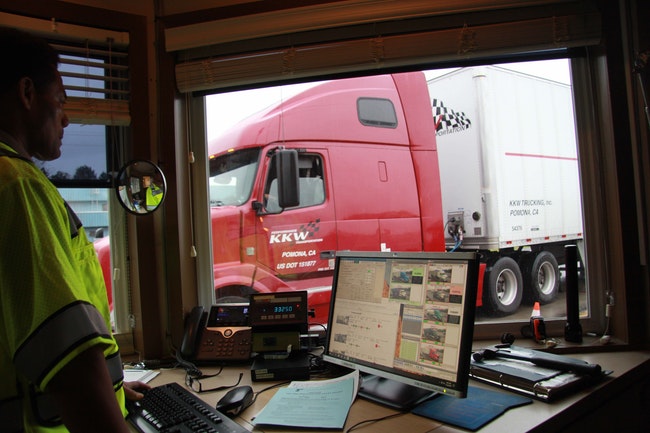
A truck stops at the weigh station at the Woodburn port of entry. (Sam Stites/Pamplin Media)
A future with electric garbage trucks and school buses and less polluting freight trucks is up for a vote in November by the state Environmental Quality Commission.
The commission is considering two new rules for manufacturing cleaner and zero-emissions medium- and heavy-duty trucks, buses and vans sold in the state. Vehicles that would be covered include everything from a Ford F250 to an Amazon delivery truck.
One rule, if approved, would require that 30-50% of new vehicles sold in Oregon are zero emissions by 2030, and 40-75% of them are by 2035.
The rule would take effect in 2024, giving manufacturers and sellers time to prepare.
The Environmental Quality Commission, a governor-appointed panel of five people, works as a sort of decision making body for the state’s Department of Environmental Quality, which would enforce the rules. The members are Kathleen George of the Grande Ronde Tribe, Sam Baraso, manager of Portland’s Clean Energy Fund, and Molly Kile, a professor at Oregon State University. Two positions on the commission are vacant.
Public comment on the new rules ended on Oct. 1. The commission is scheduled to meet and cast their votes Nov. 17-18.
“This requirement ensures that there is availability of these types of vehicles for purchase,” said Rachel Sakata, DEQ senior air quality planner. She said the department wants to be clear that this wouldn’t force companies and school districts to buy electric vehicles, but would make it easier and cheaper for them to do it over time. The idea is that by mandating industry manufacture and sell more of these vehicles, the supply will grow and buyers would have more options and price points.
Because that rule wouldn’t end manufacturing and sales of diesel-burning engines in large vehicles, the second rule on the table has to do with making those vehicles less polluting going forward.
Beginning in 2024, the state would require all new medium and heavy duty diesel vehicles sold in Oregon to meet new emissions standards. They would need to emit 75% less smog beginning in 2024, and 90% less smog by 2027.
The effect of adopting both rules would be overall greenhouse gas emissions reductions of 55% from these vehicles, according to a report from environmental consulting firm M.J. Bradley & Associates. The report was commissioned by the Natural Resources Defense Council and the Union of Concerned Scientists.
Transportation is the largest source of greenhouse gas emissions in Oregon, according to the DEQ.
It’s the kind of change that could have big impacts for people around the state, especially in cities along the Interstate 5 corridor.
“Diesel emissions aren’t just a Portland problem,” said Eric Feeley, an air quality planner at DEQ. “Any area where there’s people, there are diesel emissions.”
In places like west Eugene, where there is a higher proportion of people of color than the rest of the city, residents have been complaining of diesel smog for years, according to Aimée Okotie-Oyekan, an environmental and climate justice coordinator for the Eugene-Springfield chapter of the NAACP.
Okotie-Oyekan recalled listening at a Eugene City Council meeting where west Eugene residents called in frustrated about how bad the air quality had become from all the truck smog.
“People were saying there were days when it was unbearable to go out because of the smell,” she said. “And that was happening even before Covid. Imagine how these issues have compound on each other.”
The new clean trucks rules themselves come largely from California, where they were adopted last year. Oregon is one of 13 states and the District of Columbia that adopted California’s standards, which are stricter and include more ambitious emissions reduction targets than those of the federal government.
One challenge for growing electric fleets in Oregon will be fuel infrastructure.
DEQ is working with the state Transportation Department to fund more charging stations. They’re applying for federal grants to build their own, and providing some state funding to businesses and individuals to put in the stations.
Still, the state will need much more federal help to support the transition according to Sakata.
Brad Reed, a campaign manager at the non-profit environmental organization Renew Oregon said, “We hope that Congress gets itself together and can pass significant funding to build out that infrastructure. We’ve heard from businesses that they want to transition their fleets.”
He said there are financial benefits for doing so.
“There are lower maintenance costs to electric fleets, no oil changes, no transmission, no spark plugs to fail,” he said.
Another challenge will be getting manufacturers on board. According to Feeley, some diesel truck manufacturers suggest the changes to diesel emissions standards, which would require cleaner engines and longer warranties on parts and fixes, will cost them more than $50,000 per vehicle.
A study undertaken by the California Air Resources Board suggests changes would amount to $8,000 to $9,000 per vehicle.
Feeley said that the transition to electric and cleaner burning vehicles is not a question of if, but when.
“Everyone recognizes the future is zero emission vehicles. I don’t think there’s an argument there,” he said. “It’s just a matter of how we get there.”
Oregon Capital Chronicle is part of States Newsroom, a network of news bureaus supported by grants and a coalition of donors as a 501c(3) public charity. Oregon Capital Chronicle maintains editorial independence. Contact Editor Les Zaitz for questions: [email protected]. Follow Oregon Capital Chronicle on Facebook and Twitter.
STORY TIP OR IDEA? Send an email to Salem Reporter’s news team: [email protected].









